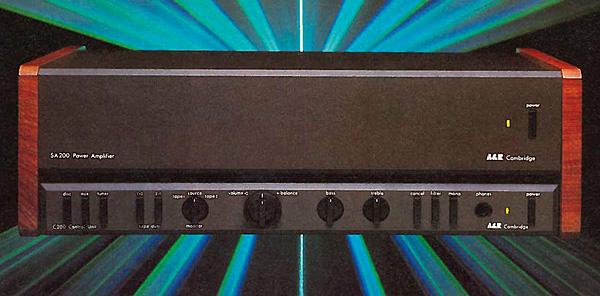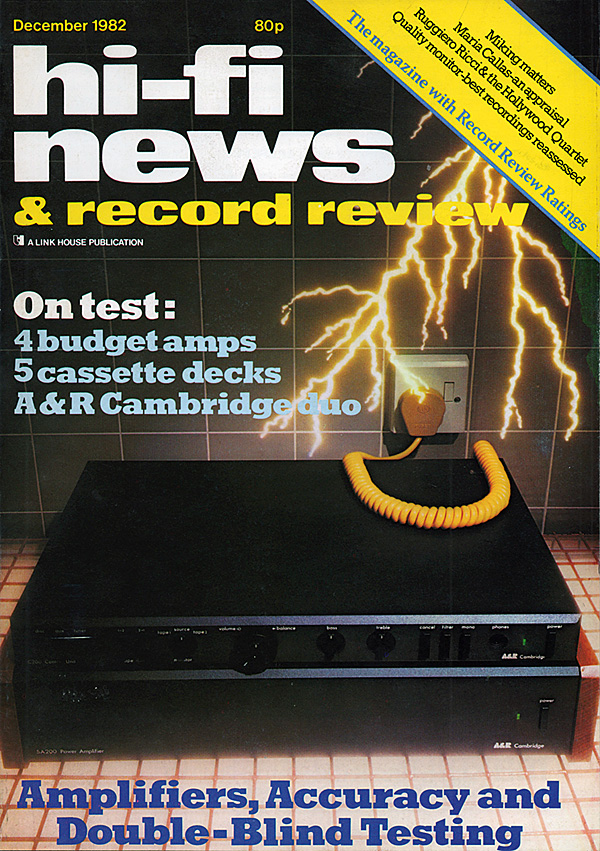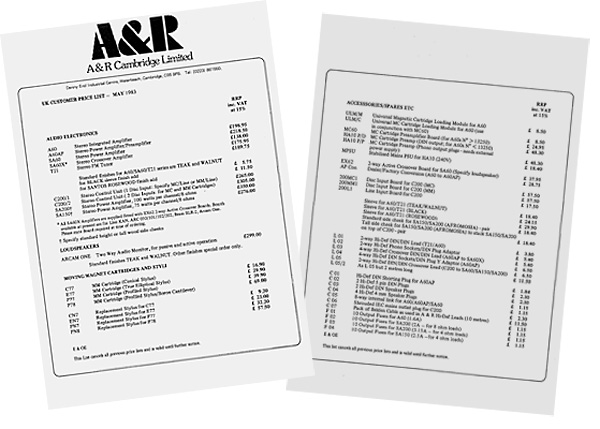A Very British Amplifier

 Martin Colloms hears the A&R Cambridge C200/SA200 pre/power duo
Martin Colloms hears the A&R Cambridge C200/SA200 pre/power duo
These new products from A&R Cambridge have been long in the pipeline. In an unusually brave step for such a small company, it has invested in moulding tooling for the front panels and also the casework of the preamplifier. Its aim was to achieve close tolerances, and considerable effort has been expended in achieving a good fit of parts, particularly for the array of controls on the preamplifier.
While the two products are clearly intended to go together, and indeed, with only a minor degradation in hum, the preamp may be stacked below the power amplifier secured by optional large side panels, they may also be considered as separate entities. Sensibly, their designer has made them self-contained and of more or less universal compatibility.

A&R's deserved reputation comes from its first amplifier, the integrated A60 model, which has enjoyed consistent support in its modest price and performance category. The 200 series marks the company's entry into the upmarket equipment arena, with a complete system price of around £600 (just under three times higher than that of the A60), the separates retailing individually for £293.25 (preamp – two disc inputs) and £299 (power amp).
SA200 Power Amplifier
Weighing 10kg and measuring 46.4cm wide, 9.5cm high and 35cm deep, the SA200 is of starkly simple appearance with a dark charcoal grey fascia flanked by light wood side panels. The controls comprise one push-button on/off switch with an adjacent green LED indicator to confirm power on/off. This LED is a two-colour type, a colour change to red signifying overload. If either or both channels overloads or clips, a latching circuit holds the red LED 'on' long enough for the overload to be visually noticeable.
The specification describes a 20dBW (100W) stereo unit, with 4-8ohm speakers provided for, plus an indication that load impedance dips to as low as 2ohm would be tolerated on music programme. The input impedance is 20kohm, a lower value than usual, but not low enough to bother any modern preamplifier that I can think of. CCIR/ARM weighted signal/noise ratio is claimed to be better than 100dB referred to 100W, 8ohm, and since the IHF standard relates to 1W this would read better than 80dB IHF.

The power rating is specified for a 20Hz-20kHz bandwidth, with a distortion figure of below 0.08% for 8ohm loads, both channels driven. A supplementary figure suggests that midband distortion is typically –74dB, for 4ohm loading up to a 160W output. The both-channels-driven supplementary power rating for 4ohm is 190W per channel, hinting at large power reserves, a claim fully confirmed on test.
The amp's rear panel carries two deep, finned, cast alloy heatsinks, and speaker connection is via close-mounted 4mm sockets, with screw down terminals. Signal input is via a 5-pin DIN socket whose connections are clearly indicated on an adjacent label, with mains feed a 13A IEC type socket.
Unscrew the lid of the SA200 and a spacious roomy layout inside means all parts may be easily reached. Mains wiring is well shrouded for safety and the interior showed a high standard of construction using fine quality components. In a dominant position lies the massive power supply toroidal transformer which has a separate secondary winding for each power amplifier. The rectification and smoothing reservoir systems used are entirely independent for left and right channels.
These latter supply components are, in fact, integral with the power amplifier assemblies and for service can be removed as complete modules, less heatsinks. Output transistors are paralleled pairs for each channel, comprising four high current devices – selected MJ5003s in a quasi-complementary, direct-coupled, push-pull class A/B configuration. A quick-blow fuse, nominally rated at 3.15A is present for loudspeaker protection, and both the fuse and the fuseholder contacts are heavily silver-plated.

In addition, the small but significant injurious non-linearities of the fuse may be largely negated by ensuring that the negative feedback loop is taken from the output terminal, after the fuse rather than, as is usually done, before it. The fuse is thus included within the loop and is subject to the linearising effect of the amplifier's negative feedback. Separate 3.15A quick-blow fuses are also present in each supply line.
To The Limit
The overload indicator is worth a note. Based in an idea previously used by both B&O and Lentek, a circuit monitors the input and output signals for both amplifiers, checking for errors. Once a deviation is detected, overload has occurred, no matter how momentary. The indicator is fitted with a delaying hold. Whatever the loading conditions, the amplifiers are allowed to work right to the limit before the indicator illuminates.
Such a feature is useful with the SA200 since it intentionally does not carry the usual current or current voltage protection limiters which can often degrade sound quality. Within the peak capacity limits of the passive fuses the SA200 should be happy to tackle virtually any loudspeaker load. Conversely, this very feature would make it impractical in pro applications, where a fuse failure during a performance would be disastrous.
![]() Sound Quality
Sound Quality
The sonic performance of this design was undeniably impressive. Presenting a high standard on uncomplicated loading (KEF R105.4 and Spendor BC1 loudspeakers were used), it provided a high degree of stereo separation with fine clarity, transparency and depth, the latter being particularly good for a model in this price range.
The bass seemed well extended as well as tight and powerful, demonstrating good 'attack'. The midrange was essentially neutral with perhaps a mere hint of 'coldness' or lightness, while high frequencies were also very good, with clear sibilants and a pleasant differentiation of the harmonic timbre of treble-based instruments.
In terms of dynamic range it is undoubtedly a 'big' amplifier, easily delivering 100W plus, with little tonal differentiation at full power and a graceful, quick recovery from clipping. However, it really came into its own on more difficult loads.
A pair of the new AR98LS speakers were tried and sounded dismal with the TAN901 power amp (a smaller Sony Esprit, although to do the 901 justice we later found out that it was an 8ohm preferred model). Not only was the sound with the 901 second-rate, there also seemed to be little available power.
Substituting the SA200 brought a transformation. The AR98LS came to life, with power, dynamic range and depth seemingly impossible with the small Esprit. By the time the red overload had come on, the sound levels were shaking the room. Subjectively judged, then, the SA200 is an effortless performer with a wide dynamic range.
On the debit side, I was mildly worried by a very slight mains hum emanating from the loudspeakers, audible notably with the more sensitive types, while some mechanical transformer hum, especially in the evenings, was a also observable. The latter could not be entirety removed by placing the amplifier in a cupboard.
Conclusion
In our lab tests the SA200 amp demonstrated a generous power capacity and exceptional load tolerance, plus wide frequency response and a low incidence of distortion. An equally good result was obtained from the listening tests, and in its price category (£300+ level) this would appear to be one of the best British-designed-and-built power amps to have appeared for some years now – a warm recommendation is in order here. Its nearest performance relative is probably the Hafler DH-200, another fine design.
























































